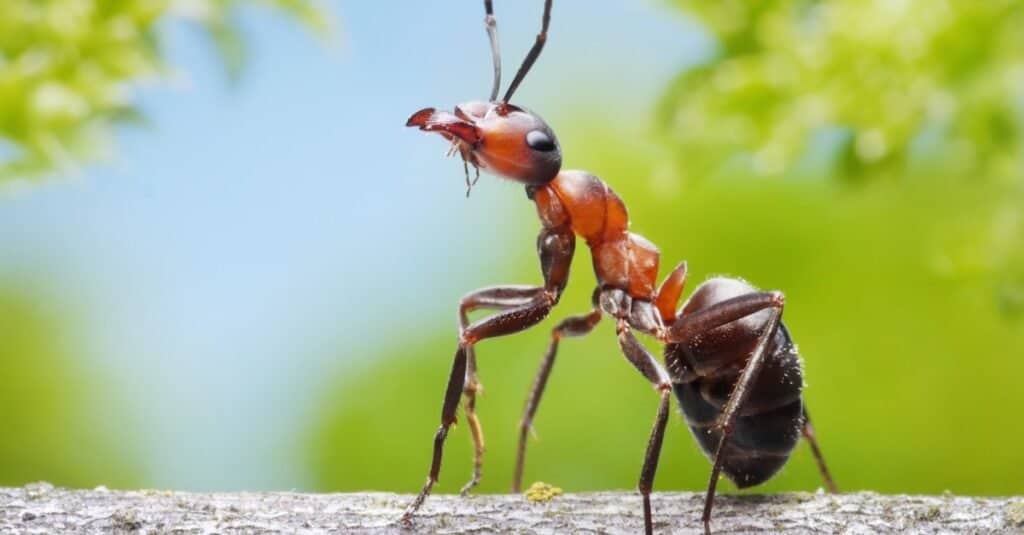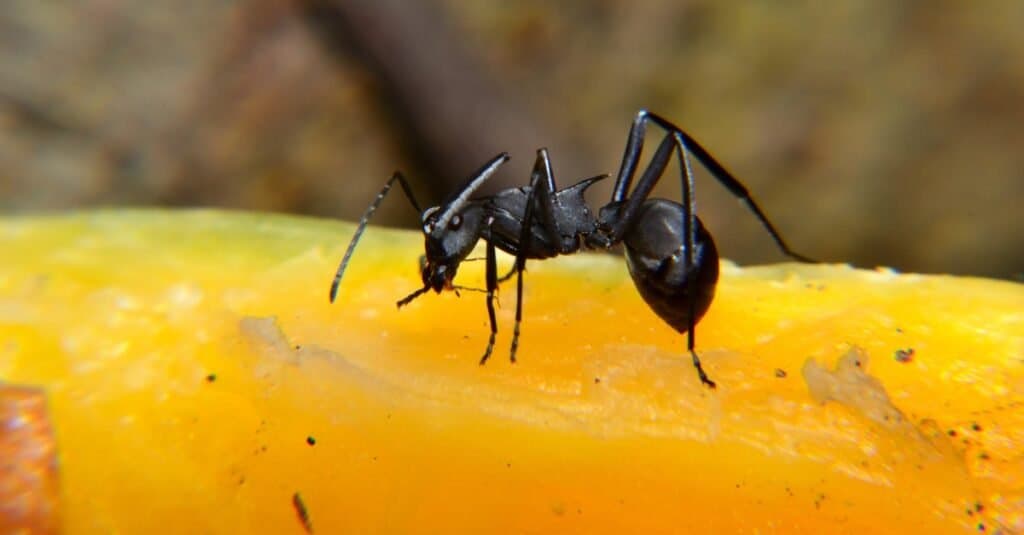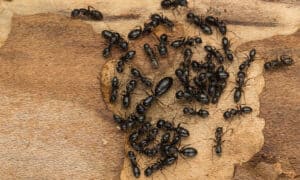There are over 12,000 species of ants which all have various behaviors. Ants are active insects; some, like the worker ants, sleep for roughly four hours and 48 minutes daily. Queen ants sleep for much longer. But are ants nocturnal or diurnal? We delve into the mysterious sleeping behavior of ants to find answers to when and how these industrious little insects take a break or if they do.
The Sleep and Activity Patterns of Ants Depend on Their Species

Ant species can be strictly diurnal, crepuscular, or nocturnal and sleep throughout the day.
©Andrey Pavlov/Shutterstock.com
Different ant species can be strictly diurnal, crepuscular, or nocturnal. There are roughly 12,000 species of ants, and the sleeping and activity behavior within the species varies. Additionally, some species can switch from diurnal to nocturnal lifestyles due to environmental demands. Examples of ecological demands include the availability of resources, the presence of predators, and the climate.
The Sleep Behavior of Ants
A study of ant sleep patterns found that queens sleep an average of 9.4 hours daily. There is also compelling evidence that the queen ant dreams while she sleeps. This proof follows research findings showing that the queen ant’s antennae vibrate during sleep. This sleep behavior is similar to rapid eye movements (REM) in humans because when people dream, their eyelids flutter during REM sleep.
Worker ants sleep much less than the queen, and their sleeping habits differ. Worker ants take hundreds of short naps a day to sleep. Researchers have observed how worker ants take up to 250 sleep breaks of approximately one minute each within 24 hours to rest. These breaks mean that the worker ants only get an average of four hours and 48 minutes of sleep per day.
But studies have also found that worker ants sleep more if there are quiet periods in the day. Worker ants are unlikely to reach stages of sleep deep enough to dream. However, scientists are still not entirely sure that this theory is correct.
Ants sleep by staying still with their antennae retracted. Sleeping ants can be difficult to spot because they don’t curl up or close their eyes. The main clue is that the ant does not move. Ants may be sluggish after waking from sleep.
Where Do Ants Sleep?
Ants don’t sleep at specific times, but they may choose to sleep where they feel safe from danger. The best place for them to rest is in their nest, where many other ants protect them and are not exposed. However, they may choose to sleep outside the nest if they are in a hidden area. Nocturnal or diurnal ants will also rest on the underside of a leaf or some form of cover if convenient.
The Nocturnal and Daily Activity of Ants

Ants often sleep in their nests but may sleep under cover outside the nest when convenient.
©iStock.com/Antrey
Ant societies and their daily activities are pretty complex. The different types of ants have separate responsibilities and daily activities. Most operate under a caste system ruled by a fertile, winged queen. Worker ants include fertile, wingless females and winged males, called drones. Drones, also called kings, are winged, fertile males born from unfertilized eggs. Mating is the drone’s job; it dies as soon as it completes the mating process. Soldiers are wingless, sterile female ants.
The winged female’s eggs hatch in the colony, creating the start of a new ant colony. The hatched female leaves the natal colony to mate with the drone. She then starts a new settlement and sheds her wings to become the queen, and she must lay the eggs. Much of the responsibility of supervising the eggs and caring for the young falls on the worker ants. In addition to raising the young, worker ants forage for the colony’s food and protect the nest from unwanted visitors.
Nocturnal or Not, Many Ant Species Enter a Form of Hibernation
Diapause isn’t technically a form of sleep; it’s simply a way to avoid the harshest conditions of the cold months. In this state, the ants move very little, and their metabolism slows down, so they don’t need to eat. Most insects become inactive when cold. This behavior is because they do not generate heat and require external heat to move. It is difficult to ascertain whether insects are cold, in diapause, or asleep. Usually, sleeping ants stop moving, and their antennae droop.
Before entering diapause, ants store energy in their bodies to survive the winter without food. In most species that live in temperate climates, the worker ants stop foraging and become inactive in the winter. Meanwhile, the queen ants rest and stop laying eggs. Larvae, on the other hand, stop growing. Their activity is significantly reduced so that they can survive for months on their energy reserves.
While in diapause, ants use different methods to survive. And even in diapause, ants can freeze to death if it is too cold. They usually seek shelter to keep themselves warm enough in their nests. Ants will also dig deeper into areas where the earth is warmer. Another way to stay warm is to bury themselves under a rock. The rock captures the sun’s heat and radiates it to the ants. Another ingenious heat source ants use is plants’ decomposition, such as decaying wood and leaves. Spending time on leaves or under rotting bark gives them enough heat to survive.
Some Pet Ant Species Require Diapause

Some
pet ants
may need to enter diapause, no matter if they are nocturnal, diurnal, or crepuscular.
©Kras_Stock/Shutterstock.com
Ant species from temperate and Mediterranean origins may need to enter the state of diapause. In winter, the ants slow down, and the queen ant doesn’t lay as many eggs. This behavior indicates an impending diapause. In contrast, tropical ants do not enter diapause in winter.
Don’t Warm Your Pet Ant Winter Colony
You can prevent ants from entering diapause by keeping the nest warm in winter. But some species of ants enter diapause regardless of the temperature. Experts assume that their biological clock governs this behavior. However, preventing diapause is not recommended, as it is a natural state and necessary for the species that engage in this sleeping behavior. Skipping diapause causes ant colonies to grow slower, workers to be smaller, and lifespans to be shorter in the long run.
Prep Your Pet Ant Colony Slowly for Winter
To prepare your ants for diapause, a gradual reduction in room temperature is necessary at about two to three weeks before the winter starts. This gradual temperature reduction will facilitate the colony’s transition into dormancy. To achieve this state, gradually reduce the heating in the room and eventually turn it off.
Then move the ants to an area where it is cooler. You can also put the ant colony in a mini fridge. If you use a refrigerator, you should start at the highest temperature and slowly decrease it over time. Do not prepare your ant colony for diapause by using the lowest fridge temperature. The optimal temperature should be between 60- and 65 degrees Fahrenheit.
Keep the Colony Moist in Winter
To care for your ants during diapause, you do not need to feed them, but you should provide them with water or moisture. But, do not introduce as much humidity to their enclosure as you do in the warmer months, as their nest will take longer to dry in the winter. If you keep the ants in a fridge, you must add moisture to their colony more frequently.
How Do Nocturnal and Other Ant Species See in the Dark?
Ants occupy various niches, from the darkest to the brightest habitats on earth. These hardworking little insects operate in environments with all levels of lighting. Nocturnal ants move around similarly in low-light habitats as diurnal ant species. They use strategies like deriving visual compass information from celestial and terrestrial cues.
Nocturnal ants use local and distant terrestrial landmark information to move around in their dark and confined habitats. Even in low light, the ant’s visual system is sensitive and can detect subtle changes in panoramas of familiar landmarks.
However, as light intensity decreases at night, visual navigation information becomes more difficult to access, and the ants’ ability to navigate also decreases. Because of this, visually-guided nocturnal ants perform much of their navigational tasks during twilight. To improve visual reliability in low-light conditions, they developed various optical adaptations, including significant facets and wide rhabdoms, along with slowing the response time of photoreceptors. In other words, they can adapt their visual structures to see better in the dark, providing us with more insight into the capabilities of these incredible insects.
Nocturnal vs. Diurnal: What’s The Difference?
Navigate to Nocturnal vs. Diurnal: What’s The Difference? for further information about the nocturnal and diurnal phenomenon in various living creatures.
Up Next –
- The 10 Largest Ants In The World
- Red Ants vs Black Ants: 5 Differences to Consider
- Termites vs Ants – The 6 Key Differences
- The 6 Best Books About Ants Reviewed and Ranked
The photo featured at the top of this post is © Poravute Siriphiroon/Shutterstock.com
Sources
- St. Petersburg State University, Available here: https://entomology.bio.spbu.ru/personal/kipyatkov/pdf/publ/kipyatkov2001b.pdf
- Oxford University Press, Available here: https://oumnh.ox.ac.uk/learn-all-about-ants-0
- ResearchGate, Available here: https://www.researchgate.net/publication/227323046_Polyphasic_WakeSleep_Episodes_in_the_Fire_Ant_Solenopsis_Invicta
- Oxford University Press, Available here: https://academic.oup.com/icb/article/57/5/1104/4079673
Thank you for reading! Have some feedback for us? Contact the AZ Animals editorial team.






